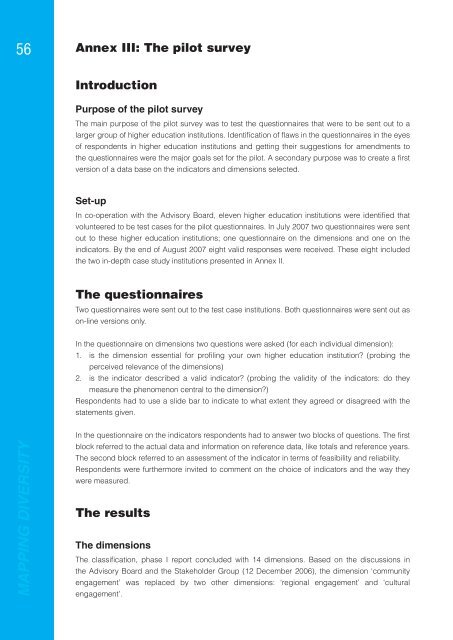Mapping Diversity: Developing a European Classification of ... - U-Map
Mapping Diversity: Developing a European Classification of ... - U-Map
Mapping Diversity: Developing a European Classification of ... - U-Map
Create successful ePaper yourself
Turn your PDF publications into a flip-book with our unique Google optimized e-Paper software.
56 Annex III: The pilot survey<br />
Introduction<br />
Purpose <strong>of</strong> the pilot survey<br />
The main purpose <strong>of</strong> the pilot survey was to test the questionnaires that were to be sent out to a<br />
larger group <strong>of</strong> higher education institutions. Identifi cation <strong>of</strong> fl aws in the questionnaires in the eyes<br />
<strong>of</strong> respondents in higher education institutions and getting their suggestions for amendments to<br />
the questionnaires were the major goals set for the pilot. A secondary purpose was to create a fi rst<br />
version <strong>of</strong> a data base on the indicators and dimensions selected.<br />
Set-up<br />
In co-operation with the Advisory Board, eleven higher education institutions were identifi ed that<br />
volunteered to be test cases for the pilot questionnaires. In July 2007 two questionnaires were sent<br />
out to these higher education institutions; one questionnaire on the dimensions and one on the<br />
indicators. By the end <strong>of</strong> August 2007 eight valid responses were received. These eight included<br />
the two in-depth case study institutions presented in Annex II.<br />
The questionnaires<br />
Two questionnaires were sent out to the test case institutions. Both questionnaires were sent out as<br />
on-line versions only.<br />
In the questionnaire on dimensions two questions were asked (for each individual dimension):<br />
1. is the dimension essential for pr<strong>of</strong>i ling your own higher education institution? (probing the<br />
perceived relevance <strong>of</strong> the dimensions)<br />
2. is the indicator described a valid indicator? (probing the validity <strong>of</strong> the indicators: do they<br />
measure the phenomenon central to the dimension?)<br />
Respondents had to use a slide bar to indicate to what extent they agreed or disagreed with the<br />
statements given.<br />
MAPPING DIVERSITY<br />
In the questionnaire on the indicators respondents had to answer two blocks <strong>of</strong> questions. The fi rst<br />
block referred to the actual data and information on reference data, like totals and reference years.<br />
The second block referred to an assessment <strong>of</strong> the indicator in terms <strong>of</strong> feasibility and reliability.<br />
Respondents were furthermore invited to comment on the choice <strong>of</strong> indicators and the way they<br />
were measured.<br />
The results<br />
The dimensions<br />
The classifi cation, phase I report concluded with 14 dimensions. Based on the discussions in<br />
the Advisory Board and the Stakeholder Group (12 December 2006), the dimension ‘community<br />
engagement’ was replaced by two other dimensions: ‘regional engagement’ and ‘cultural<br />
engagement’.

















